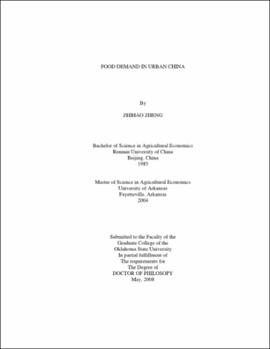| dc.contributor.advisor | Henneberry, Shida R. | |
| dc.contributor.author | Zheng, Zhihao | |
| dc.date.accessioned | 2013-11-26T08:22:08Z | |
| dc.date.available | 2013-11-26T08:22:08Z | |
| dc.date.issued | 2008-05 | |
| dc.identifier.uri | https://hdl.handle.net/11244/6550 | |
| dc.description.abstract | Scope and Method of Study: This study is composed of three essays. The objective of the first essay is to estimate the impacts of economic and non-economic factors on food consumption patterns in urban China. A complete food demand system of households is estimated using a two-stage budgeting procedure which incorporates both an almost ideal demand system (AIDS) and a quadratic almost ideal demand system (QUAIDS) in each stage. The purpose of the second essay is to determine the differences in price and income elasticities across income classes in urban China. An incomplete demand system for 10 major food commodity groups is estimated using the LINQUAD model, which is defined as being linear in income and linear and quadratic in prices, for low-, medium-, and high-income groups, respectively. The third essay estimates the impact of changes in income distribution on food demand in urban China. This essay is based on the estimates obtained in the second essay. All the three essays use the 2004 China's urban household survey data for Jiangsu province. | |
| dc.description.abstract | Findings and Conclusions: The results of the first essay show that the demand for animal products is significantly more sensitive to consumer food expenditure changes than other food categories, while the demand for grains and oils & fats depends more on price changes than income changes. Moreover, the demographic profile of urban consumers in Jiangsu does have a significant impact on the food demand. Finally, the AIDS and the QUAIDS models yield very similar results in this application. The results of the second essay show that the high-income households in urban Jiangsu are less responsive to price and income changes for most food groups considered in this study compared to the low- and medium-income families. The results of experiment simulation in the third essay show that a drive toward a more equal distribution of income would increase expenditures for food groups that were consumed at home. | |
| dc.format | application/pdf | |
| dc.language | en_US | |
| dc.rights | Copyright is held by the author who has granted the Oklahoma State University Library the non-exclusive right to share this material in its institutional repository. Contact Digital Library Services at lib-dls@okstate.edu or 405-744-9161 for the permission policy on the use, reproduction or distribution of this material. | |
| dc.title | Food demand in urban China | |
| dc.contributor.committeeMember | Brorsen, B. Wade | |
| dc.contributor.committeeMember | Holcomb, Rodney B. | |
| dc.contributor.committeeMember | Warde, William D. | |
| dc.contributor.committeeMember | Wailes, Eric J. | |
| osu.filename | Zheng_okstate_0664D_2714.pdf | |
| osu.accesstype | Open Access | |
| dc.type.genre | Dissertation | |
| dc.type.material | Text | |
| thesis.degree.discipline | Agricultural Economics | |
| thesis.degree.grantor | Oklahoma State University | |
